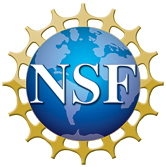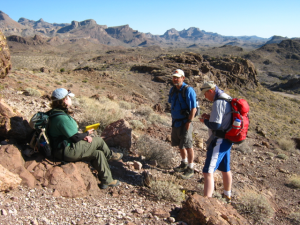This REU has now completed its third and final year. Thanks for your interest, and best of luck finding a great research opportunity!
_______________________________________________
Supereruptions – explosive events that eject more than 1000 cubic kilometers of volcanic material – capture our imagination and compel us to consider the potential effects of one of Earth’s rarest yet deadliest acts. Comprehending what led to supereruptions in the past is essential to understanding and predicting similar events in places where geologically recent supereruptive activity suggests a threat, including the U.S. (e.g. Yellowstone), South America (southern Andes), Indonesia, and New Zealand.
Undergraduate students participating in this REU will investigate the tumultuous magmatic history recorded by the 18- to 19-million-year-old volcanic and intrusive igneous rocks in the southern Black Mountains of northwestern Arizona and elsewhere in adjacent California and Nevada. Here, the geologic record includes the well-exposed, recently-identified (by senior participant Dr. Charles Ferguson) Silver Creek caldera, which produced the enormous Peach Spring Tuff (PST) supereruption nearly 19 million years ago. The PST is exposed over 32,000 km2 of western Arizona, southeastern California, and southern Nevada.
Moreover, the Silver Creek caldera and its immediate environs also offers a stellar record of the PST’s immediate magmatic precursors and successors, meaning that we can evaluate the long-term evolution of this volcanic center in order to gain a better understanding of how and why supereruptions are generated – topics that scientists are actively investigating, and to which the geologic record in the southern Black Mountains may provide valuable clues.
As an REU participant, you will undertake your own research project aimed at addressing one or more key supereruption-related questions:
- How does supereruptive magmatism compare to typical-scale magmatism (e.g. Mount St. Helens in 1980), and how are these connected?
- What does a supervolcano look like before it erupts?
- How and why do large magmatic systems change through time?
The REU will offer you ample opportunities to hone both your field geology skills (during two field sessions, one in the winter and one in the summer) and your laboratory skills (during a summer 2014 research session at one of the REU host schools, Vanderbilt University in Nashville, TN or Mercyhurst University in Erie, PA). You will work with the project leaders, your mentors, and the other students to design and carry out meaningful research that you will eventually present at a national geological sciences conference and may even submit for publication in a peer-reviewed journal.
In addition to great geological exposures of some phenomenal events in earth’s history, this area is home to three western cultural icons: old Route 66, a historic mining town (Oatman, AZ), and the Colorado River. You’ll get tastes of the new and old west as we relax and re-provision.
As an REU participant, you will receive a stipend of $5000 (to be distributed in summer 2015 during the summer session). In addition, the REU grant will cover all travel expenses (to/from REU sites and conferences), geology field training, lodging and food while at REU sites, and conference fees. Please see the financial breakdown on the application page for more details.
Please take the time to review this website. Feel free to contact us with any questions.
 This project was funded by the National Science Foundation Research Experience for Undergraduates program and the Division of Earth Sciences grant #EAR1263310
This project was funded by the National Science Foundation Research Experience for Undergraduates program and the Division of Earth Sciences grant #EAR1263310
Save
Save





